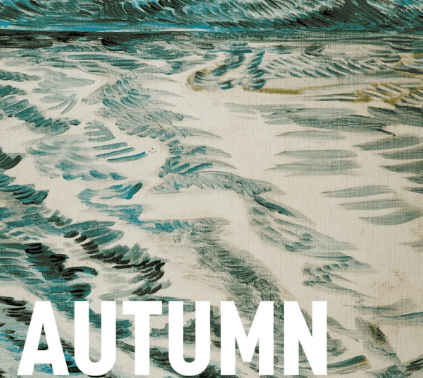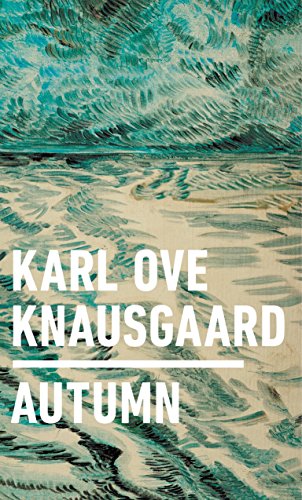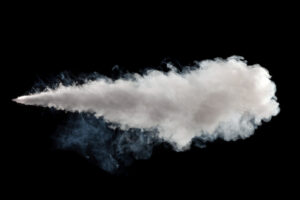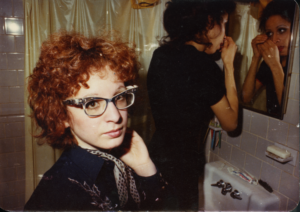Autumn
Karl Ove Knausgaard set the literary world on fire with his six-volume novel, "My Struggle." His new book is a meditation on life, time and family. Penguin Random House
Penguin Random House
“Autumn”
A book by Karl Ove Knausgaard. Translated from the Norwegian by Ingvild Burkey.
Karl Ove Knausgaard’s gigantic masterpiece of a novel, “My Struggle,” (2009-2011) was an unforgettable, autobiographical 3,500-page read, served up in six intoxicating volumes. It set the literary world on fire with its originality and candor, and shocked his fellow Norwegians who found his personal revelations distasteful. He wrote the book between 2009 and 2011 at a fast clip, generally 15-20 pages a day, which he read each morning to a trusted friend who urged him to continue. Zadie Smith compared his work to crack cocaine. And James Wood, the usually certain book critic for The New Yorker, hailed Knausgaard’s work as brilliant, but confessed he had trouble expressing precisely why. The odd thing was that the book was mostly about ordinary subjects: the life of a man trying to parent his three young children, while writing and coping with his “high-maintenance” wife Linda.
Readers fell madly in love with Knausgaard, many of them finding that his writing induced a kind of hypnotic trance. The narrative was filled with fascinating digressions and winding passages that took the reader to another realm. One became symbiotically attached to Knausgaard and the problems that encircled him. There was magic here. The work sold extremely well and was translated into several languages.
Knausgaard spends a lot of time writing about his father, an emotionally abusive man who died early from alcoholism. His father left the family home while Knausgaard was still a teenager, and he agonizingly recreates for us the tense visits with his father while he was living with a new woman. He remembers being forced to sit there politely and make small talk, while his father treated him with his usual chilly dismissiveness that could still unexpectedly erupt into terrifying outbursts of anger. This primal pain remains with Knausgaard even today as he approaches 50. Relatives of his father were deeply disturbed and embarrassed by Knausgaard’s devastating portrait of his father’s life in “My Struggle.” They cut off communication with him and threatened to sue. But Knausgaard could not, would not stop. He felt that he was creating something that hadn’t been done before. He had already written two well-received novels, but was disappointed with them. In fact, fiction in general began to disturb him. He found most of it frivolous and artificial. Each morning, before the children arose (he was their primary caregiver), he would write, pushing himself to censor the voice inside of him that attempted to quell what he really felt. His goal was simple yet enormous. He wanted to describe what it felt like to be him, what it felt like to live his life.
Knausgaard’s volumes chronicle his current preoccupations and his early years. He writes tellingly about his first marriage, which ended in divorce, and how he met and fell in love with his wife Linda, whom he met at a writer’s retreat. He recalls that she rejected him at first, and in his dejection he cut his face with a shard of glass. He was mortified the next morning at his reflection in the mirror. When they met again later on and he was able to woo her, he admits shyly that he fainted after their first kiss. He writes tenderly about the three children that soon followed their marriage. He remains, for a good portion of the narrative, stuck in his past. He tells us about the intensity of his childhood friendships, which have mostly endured, his love of his older brother, his fondness for music and the drums, and the fun he had playing in a band during the 1970s—which he remains convinced was an enchanted decade. We learn about his first girlfriends and the troubles he had as a young man with premature ejaculation. He talks a lot about his first jobs after college, one of them working as an aide in a mental institution. Through it all, he tries to write. He has harsh words for almost all his writing professors whose advice he felt was utterly useless.
He often digresses, taking the reader along with him. There are scintillating passages about his appreciation for Paul Celan, Proust, Rembrandt and Dostoevsky. Strange things occupy him. He spends pages ruminating on whether cornflakes taste better alone or drenched in milk. Always, there are flashbacks; one thought sparks another and then another. His father’s foreboding presence is always felt, like a dead weight on his heart that threatens to sink him. We can sense his anger, disappointment and impatience at times; it feels just like our own. There are snippets of hope too, but they are usually drowned out by his brooding nature.
He writes with radical candor about raising small children while wanting more time to write, and the chilling dynamics of his loveless marriage:
I wanted the maximum amount of time to myself, with the fewest disturbances possible. I wanted Linda, who was already at home looking after Heidi, to take care of everything that concerned Vanja so that I could work. … If I couldn’t because of her and her demands, I would leave her, simple as that. … The way I took revenge was to give her everything she wanted, that is, I took care of the children, I cleaned the floors, I washed the clothes. I did the food shopping. I cooked and earned the money so she had nothing tangible to complain about, as far as I and my role in the family was concerned. The only thing I didn’t give her, and it was the only thing she wanted, was my love.”
He describes with despair the feeling that his days are melting away:
Time is slipping away from me, running through my fingers like sand while I … do what? Clean floors, wash clothes, make dinner, wash up, go shopping, play with the children in play areas, bring them home, undress them, bathe them, look after them until it is bedtime, tuck them in, hang some clothes to dry, fold others, and put them away, tidy up, wipe table, chairs, and cupboards.”
He writes about the feelings of emasculation while taking his daughter to toddler play classes in her pram, and the exasperation when the women present seem not to notice him.
But in other moments he relishes his time with the children, wondering which memories of their endless days together will remain with them after he is gone. He tries to keep their schedules intact, believing strongly that routine and predictability will help make them secure adults. He seems to look at most situations through a psychological lens, but surprises us with his professed disdain of all forms of psychotherapy. When his wife once asked him to attend couples therapy with him, he refused. He believes the psychoanalytic process to be folly. He is certain that the pain and trauma you bring with you into therapy leave with you, intact.
Perhaps this is because, for all of his disclosures, there is still a part of him he is unwilling to share. He seems in many ways a man who stands apart from others as an observer. Even with his children, we sense his fondness for them, but are uncertain if he is able to read them carefully. He is often clueless as to what others are thinking and feeling. He also confesses to a persistent shyness, and never once in his life struck up a conversation with a stranger. He drinks and smokes excessively, and according to one of his closest childhood friends, there has always been a certain darkness about him that seems to be part of his genetic inheritance.
But in Knausgaard’s new work “Autumn,” one of four contemplative books on the seasons, he seems to be trying to reinvent himself, keeping the past sealed away and trying to find beauty in the world around him. The idea for this series of books came about when his wife became unexpectedly pregnant with their fourth child, a daughter they would call Anne.
The chapters in this book are brief, and topics seemingly random. Knausgaard writes about his love of gardening and his passion for the colors red and green. He comments frequently on the beauty of sunlight and how it affects our vision of the world. He cherishes happy memories spent with the children, and how freely they spoke to him during their daily drives to school. He recalls walking with them deep into the woods around their home and finding a lone apple tree, laden with ripe fruit. The children asked if they could climb the tree and partake, and Knausgaard remembers how he nodded silently and thought, “In a sudden glimpse, as full of joy as it was of sorrow, I understood what freedom is.” Later on, he eats outdoors with the children, listening to the clang of the silverware and wondering to himself if he is the only one among them who is noticing the sun hanging over the barn, “no longer blazing yellow, but orange, burning silently.”
His mind reaches back to other images of stark beauty. He remembers standing on a rowboat with his grandfather watching porpoises leap out of the water. He watches birds flying over their cottage in Sweden and wonders where they are going. He takes one of the children to a birthday party and notices the chillingly cold eyes of a frog that one child has brought to the party.
He writes about his love of old photographs and tells us about the first photograph ever taken. It was by Louis Daguerre in 1883, and showed a street lined with trees flooded by sunlight. He thinks delightedly about his unborn daughter’s sonogram picture and wonders what she will be like. He tries to tell her about her siblings, writing with great tenderness about each of his children’s births and the euphoria he experienced holding them. Once again, memories of the past interrupt his reverie. He recalls that after his father’s death, he was only able to take two items from his father’s house back home with him: rubber boots and binoculars. He realizes that he was able to take those objects, and those objects only, because they did not remind him of his father. They seemed somehow apart from him; just sturdy reliable objects that stood on their own. He remembers having a fever as a child and his mother’s soothing fingertips sweeping his forehead. She was never physically affectionate toward him, unless he was sick and bedridden.
We sense how hard Knausgaard is trying to change. But memories of his father still haunt him, and he seems still scared of whom he might one day become. One night, with guests over, he drinks and drinks. He is the only one drinking. The next morning, ashamed and hung over, he is afraid of how much the children noticed.
“Autumn” is laced with stunning and unusual insights that are pure Knausgaard. But we can also hear the muted tension of a man trying to be better, kinder and gentler than he really is. A man who wants to stop chasing time. A man tired of his own torturous history. And we want him to find the peace he is looking for. But if we are honest, there are many times while reading “Autumn” that we find ourselves desperately looking for the other Knausgaard, who wrote 3,500 pages about his ravaged soul and was willing to show us his passion, rage and seething anger. It was that Knausgaard who infiltrated our dreams.
Your support matters…Independent journalism is under threat and overshadowed by heavily funded mainstream media.
You can help level the playing field. Become a member.
Your tax-deductible contribution keeps us digging beneath the headlines to give you thought-provoking, investigative reporting and analysis that unearths what's really happening- without compromise.
Give today to support our courageous, independent journalists.







You need to be a supporter to comment.
There are currently no responses to this article.
Be the first to respond.